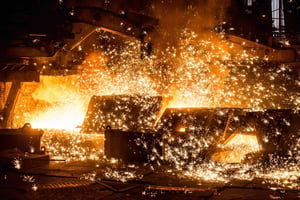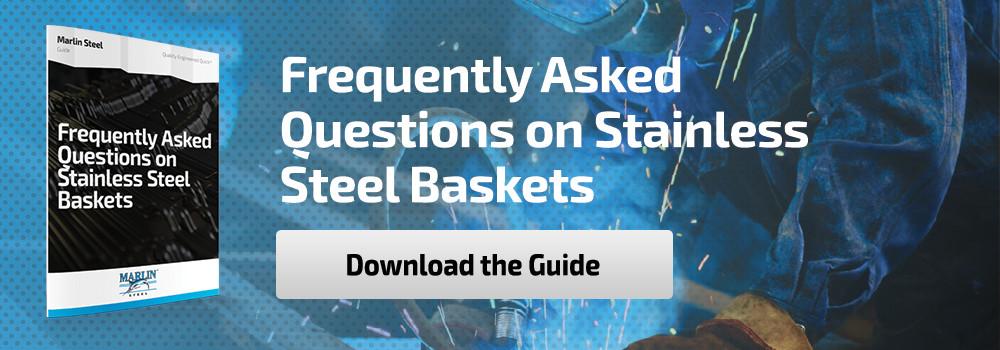 Many modern manufacturing applications involve the use of hot furnaces to complete the treatment of metallic parts. Whether the parts are being annealed, hot-flecked coated, or sterilized, prolonged exposure to furnace-like temperatures is all too common. The issue with this is that any container used to hold the parts through these superheated furnaces will, of course, themselves be exposed to those temperatures.
Many modern manufacturing applications involve the use of hot furnaces to complete the treatment of metallic parts. Whether the parts are being annealed, hot-flecked coated, or sterilized, prolonged exposure to furnace-like temperatures is all too common. The issue with this is that any container used to hold the parts through these superheated furnaces will, of course, themselves be exposed to those temperatures.
Baskets meant to hold parts through furnace-like conditions need to be made of materials that can withstand extreme temperatures. Stainless steels often have high temperature tolerances—but which is the best stainless steel for high temperature applications?
The answer depends on not only the precise temperature the application will reach, but on the length of time the basket will be exposed to the high temperatures—which is why many metal alloys specify both an intermittent and continuous use temperature.
Continuous and Intermittent Service Temperatures of Stainless Steel Alloys
When specifying a metal for a given furnace application, it’s often necessary to know whether or not the alloy will be exposed to the temperatures for a few seconds, a few minutes, or an hour or more. Short, periodic exposure interrupted by removal from the furnace to cool is called intermittent exposure, while prolonged immersion in the furnace is called continuous exposure.
The thing is, a metal alloy might have different tolerances for exposure to high temperatures depending on whether said exposure is continuous or intermittent. Here are some examples of continuous and intermittent stainless steel temperature limits:
- Grade 304
- Continuous: 1,700°F (925°C)
- Intermittent: 1,600°F (870°C)
- Grade 309
- Continuous: 2,000°F (1,095°C)
- Intermittent: 1,800°F (980°C)
- Grade 310
- Continuous: 2,100°F (1,150°C)
- Intermittent: 1,900°F (1,025°C)
- Grade 316
- Continuous: 1,700°F (925°C)
- Intermittent: 1,600°F (870°C)
- Grade 410
- Continuous: 1,300°F (705°C)
- Intermittent: 1,500°F (815°C)
- Grade 420
- Continuous: 1,150°F (620°C)
- Intermittent: 1,350°F (735°C)
- Grade 430
- Continuous: 1,500°F (815°C)
- Intermittent: 1,600°F (870°C)
You may have noticed an odd and potentially counterintuitive trend for the 300-series stainless steel alloys listed here. Specifically, their continuous recommended maximum use temperature is higher than their periodic, intermittent use temperature limits. It is natural to assume that exposing the metal to high temperatures for a shorter time would place less strain on it than longer exposure would.
However, intermittent furnace exposure introduces a different stress factor than just the heat itself—a phenomenon known as “thermal cycling.” When a piece of metal is rapidly switched between temperature extremes, several things can happen.
As metal heats up, it can expand, then it may contract as it cools. Additionally, steel alloys in furnace-like conditions can form scale across their surfaces—a kind of flaky substance made from iron and iron oxide—which replaces the outer layer of the metal.
When cycled between high and low temperatures repeatedly, the scale can begin to crack and split, weakening the metal form. This can occur because of differences in the coefficient of expansion between the stainless steel core of the metal and its scale surface. To put it in layman’s terms, the inside of the metal expands or contracts at one rate, and the scale on the surface at another. This difference causes the metal to start breaking apart, layer by layer, until it finally fails.
Which Metal is the Best for My Furnace Application?
Choosing the best alloy to use for your particular furnace-related processing tasks will be a matter of not just what temperatures the alloy can take for intermittent and/or continuous use, but of the cost of that alloy versus its performance.
For example, consider Inconel 600®. This is an alloy that’s tailor-made to be used in extreme temperature conditions. This alloy has a continuous operating temperature of around 2,000°F (1,093°C)—making it comparable to grade 309 stainless steel.
However, there may be a significant cost difference between the name-brand Inconel® alloy and a more generic stainless steel that can severely impact the cost to acquire a basket made out of the metal without greatly affecting the basket’s useful life or versatility.
In other cases, you might need to consider the chemical resistance of the metal in addition to its operating temperature to create a custom wire basket that can hold your parts through multiple processes beyond the furnace.
If you need help picking the right kind of metal alloy for your next custom wire basket, contact the experts at Marlin Steel today! Marlin’s engineering team has years of experience in helping manufacturers tackle countless challenges related to temperature extremes and chemical corrosion, and can leverage that experience to help you create a better furnace basket!



.gif)


